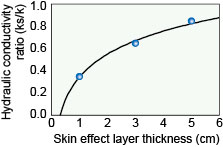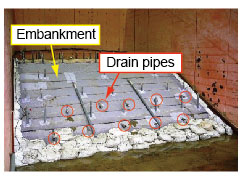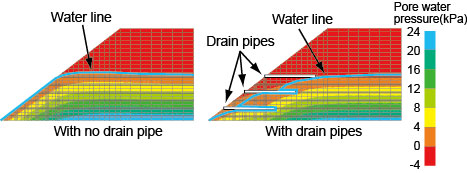8.Method for evaluating the rain resistance of embankments with embedded drain pipes
- A method was developed for evaluating the resistance to rain of embankments with embedded drain pipes.
- By virtue of quantitative evaluation of the effects of a drain pipe on reducing water levels and pore water pressure, it is possible to select the appropriate work measures to be applied.
Considerable achievements have already been made in using drain pipes as a measure for increasing embankment resistance to rain water. However, so far no method has been established for evaluating the effects of such work. Consequently a proposal has been made for an analytical method to evaluate the rain water resistance properties of embankments, on the basis of a seepage model capable of quantitatively reproducing the effects of a drain pipe.
Although it is said that drain pipes function as a means to reduce water levels and pore water pressure in embankments, this function has never been quantitatively assessed. The aforementioned effect was therefore verified with a small scale model of a cylindrical tube in an embankment, which was then reproduced in a subsequently designed analytical model (Fig.1). The suitability of this analytical model was then verified itself (Fig.2) through trials on a full scale model of an embankment.
The outcome of the aforementioned analyses and tests revealed that a low permeability layer (skin effect) formed around the embedded drain pipe. The function of the thickness of this skin effect layer and its permeability (ratio of embankment hydraulic conductivity to skin effect hydraulic conductivity) was then found (Fig.3). This function can be used to determine the permeability found through the analytical model for randomly selected skin effect layer thicknesses. Furthermore, by using the pore water pressure distribution obtained by virtue of the developed analytical model, it is possible to calculate the safety of the embankment slope, and correctly evaluate the rain resistance of embankments with embedded drain pipes (Fig.4). In addition, this evaluation method can be used to determine which work will be most effective, by calculating the optimal number of pipes to be embedded and spacing distance, thereby improving the rain resistance of embankments.

Fig.1 Analytical model of drain pipe
Fig.3 Function of skin effect layer
thickness to permeability

Fig.2 Full scale model test on embankment
Fig.4 Water level and pore water pressure distribution
obtained using the proposed analytical model